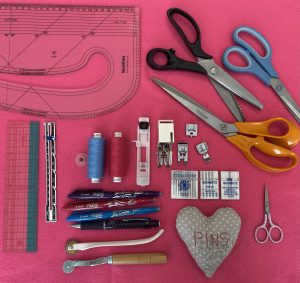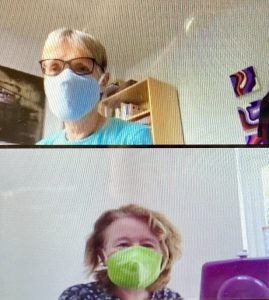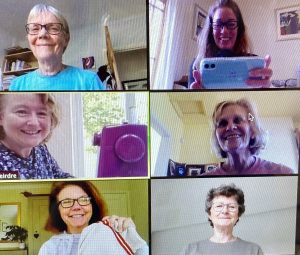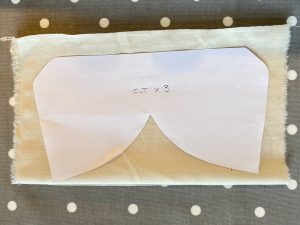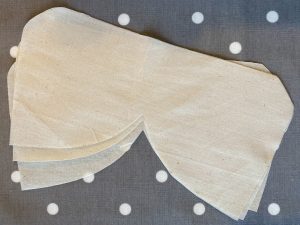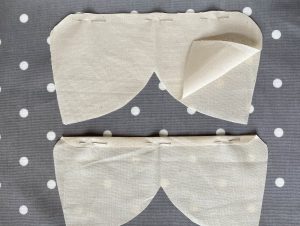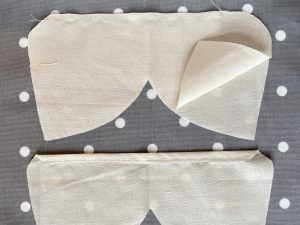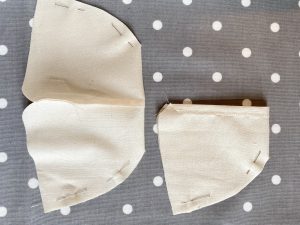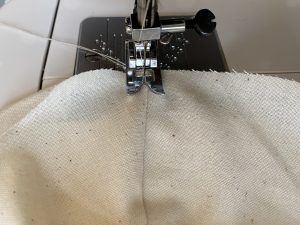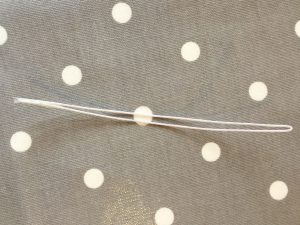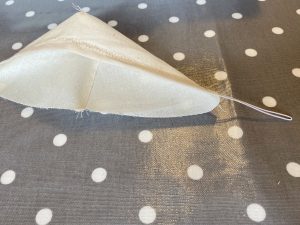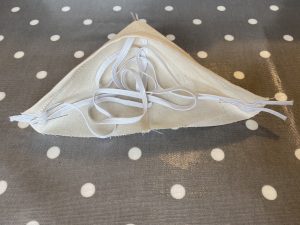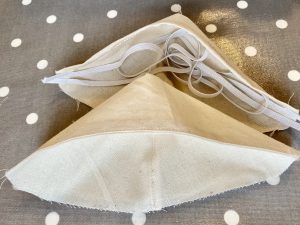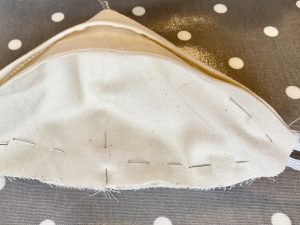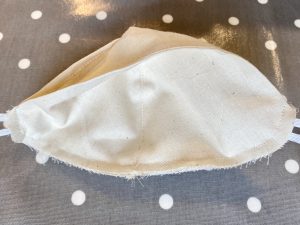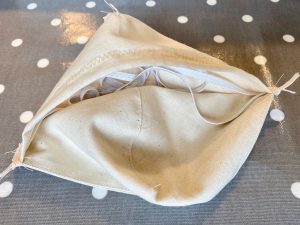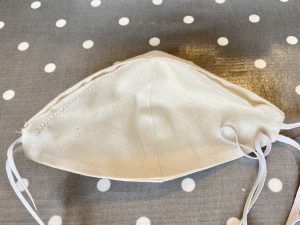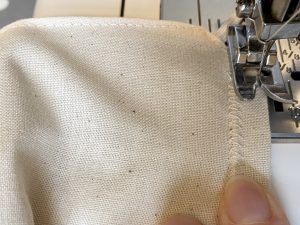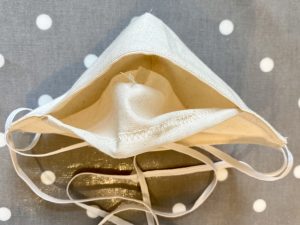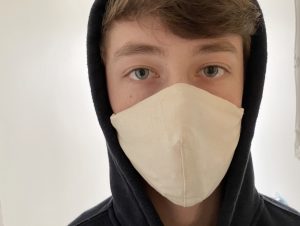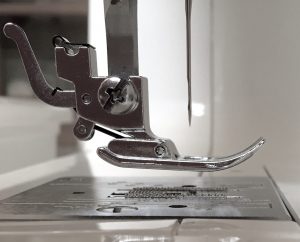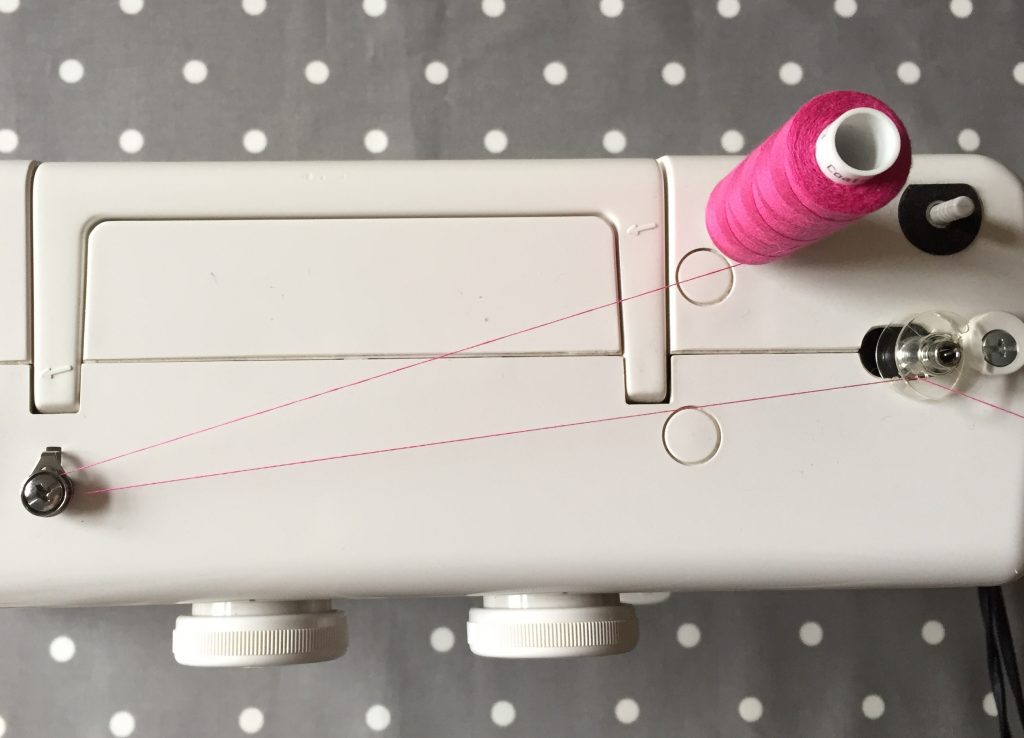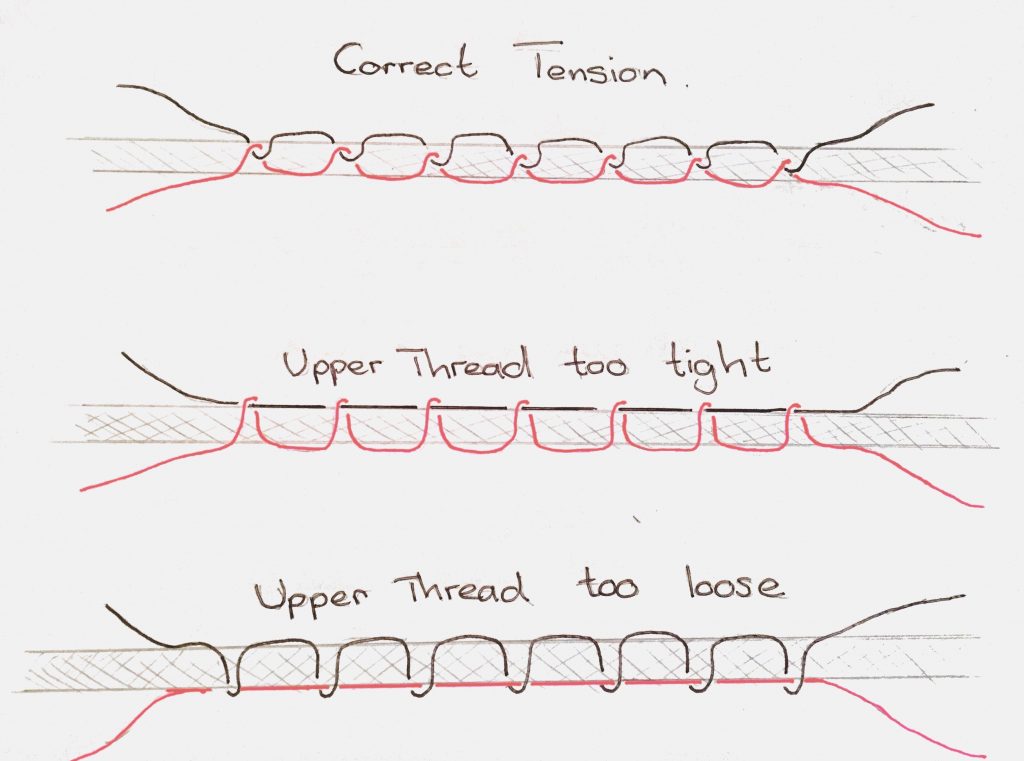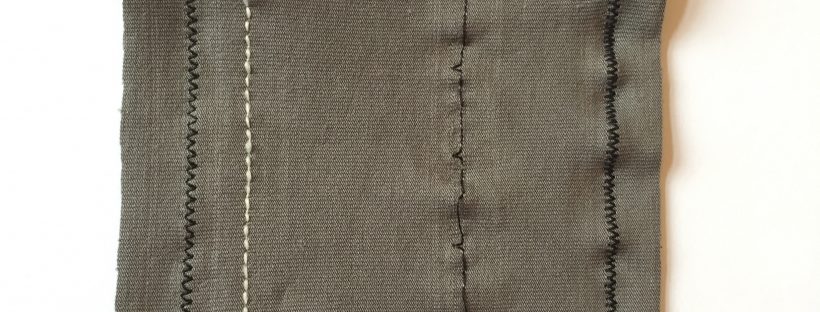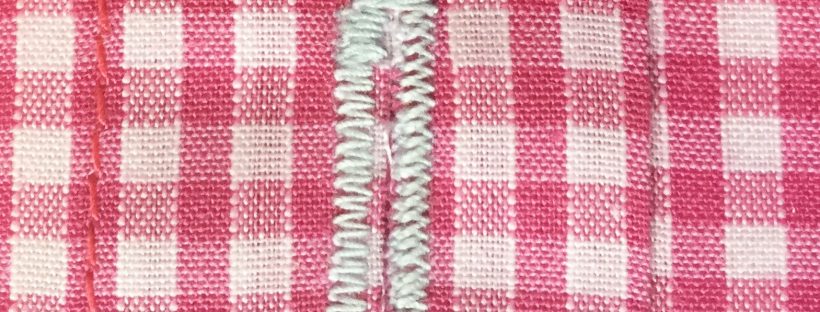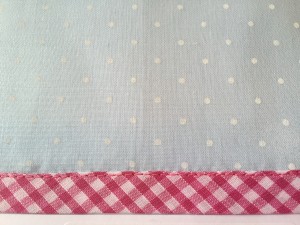Category: Uncategorised
Interfacings
INTERFACING is an extra layer that is attached to the back of your main fabric to give more body, to stiffen it and/or to stabilise it. Once it’s ‘backed’ onto the main fabric, it is then treated as one.
There are many different options and weights of interfacing, so to decide which one to use, think about what it needs to do…
You may want to stiffen something a little bit or even a lot, such as a collar and cuffs on a blouse compared to a mans formal shirt. You may want to give something structure so it can hold it’s shape and not collapse, such as a bag or maybe a sculptural piece of clothing. You may want to stop something stretching, such as a neckline or curved waistline. You may want to stabilise something but still keep the stretch, such as the neck line on a stretch garment.
It’s always a good idea to test some options on a piece of scrap first. If you have a small stock of various interfacings to experiment with, you can choose the best one for the effect you want. With clothing I prefer to start with less and build up, rather than using anything too heavy and rigid. The one I use the most when dress making in my classes is Vilene H180 fusible. It’s nice and soft so the fabric still behaves like fabric.
When using fusible interfacing, be careful not to melt it… you need the iron hot enough to melt the glue so it can fuse to the back of your fabric but its a fine line! To be safe you can use a pressing cloth but you can also press from the right side of your fabric if it can take a high heat.
I have taken the following information from William Gee, a family run haberdashery in London. I buy all my interfacings online from here and I have never been disappointed. https://www.williamgee.co.uk
It’s what’s on the inside that counts…
It’s an old adage that it is what is on the inside that counts, and when it comes to constructing a professional garment, it makes a huge difference to collars, cuffs, waistbands and more…
There are three main types of interfacing:
- Non – woven: made from fibres all pressed together it creates a fabric like felt or paper. It has no grain, so avoid wastage by cutting any which way. It offers a firm support and no flexibility. It also tends to be the cheapest option.
- Woven: have a grain and should be treated like other woven fabrics. They are more flexible and tend to be softer.
- Knit: are the most flexible of interfacing, they have two-way stretch and are used to add support without compromising the stretch of a fabric.
You can buy these as fusible (with glue you can iron-on) or sew-in; they come in various weights. Vilene is the biggest company that produces these fabrics and they tend to be the best quality.
With fusible interfacing make sure that you place the shiny side down on the wrong side of your fabric and iron. Try not to get glue on your iron as it ends up a big sticky mess that will transfer to everything you try to iron afterwards. Keep it clean with an iron cleaner stick. Or if you’re lucky and have a lot of space have a spare ironing board cover and iron just for these sticky jobs.
To take your garment to the next level, why not try some more traditional, high-end interfacings?
Silk organza: Used on lightweight fabrics to add body or “puff” so try it in sleeves for extra puff or as petticoats for full skirts (not as scratchy as net or tulle!) but it can also be used in collars and cuffs for lightweight support – think blouse not dinner shirt.
Top tip! Save your silk organza scraps and use them as ironing cloths. You can see through them and it will help reduce shine or burns caused by your iron on delicate fabrics.
Power net/tricot: A soft knit fabric that can offer some support to the wearer as well as the garment. Embrace your inner couturier and try inserting a corselette into a wiggle dress to smooth those lumps and bumps! If you are making a vintage dress why not try cotton bobbinette like the Dior “New Look” dresses
Horsehair: Not actually horsehair anymore, otherwise known as canvas (sometimes mixed with goats hair). This is usually used in tailoring for jackets and waistbands. Not ready for Saville Row yet? Try pad stitching a waistband on a skirt or trousers and notice the difference! Pad stitching is a form of stitching that attaches the interfacing to the main fabric. Through a series of long stitches you can help mould and shape the fabric. Time consuming but gives beautiful results.
Taffeta: Beautiful for silks or medium cottons. The stiffness of this fabric makes it great for interfacing.
Petersham ribbon: Do not confuse this with grosgrain. Petersham ribbon is stiff and ridged like grosgrain but the edge of the ribbon is bumpy and it can bend a bit like bias binding (whereas grosgrain can’t). This is excellent to use as waistbanding but also for waist-stays and supporting a neckline on a strapless dress.
SEWING LESSONS VIA ZOOM
As Covid-19 has sometimes made it impossible to teach sewing face to face, ‘Sew Zoom’ lessons have become a fantastic alternative. I’ve been so pleased with how it’s worked for my regular classes that I’m going to continue to offer the option of Zoom sewing lessons from now on. I believe that for those with time or travel restrictions, it could be a real solution! You will of course need the use of a sewing machine and some other bits depending on what you are wanting to learn.
HOW IT WORKS:
Zoom is easy to use and it’s free! You don’t need a Zoom account to attend a lesson, you don’t even need to download the free app if you don’t want to… it’s up to you. All you need is a computer, iPad or mobile… the bigger the screen the better as we can see what’s going on more clearly. I also like to use Whatsapp along side Sew Zoom, to share close ups, instructions and videos.
If you know how to use Zoom that’s great, but if not, please don’t worry, I’m very patient and happy to show you the ropes! To start with, I’ll email you an invitation to attend a ‘Zoom Meeting’. Then on the arranged date and time you just click the link in the email under ‘Join Zoom Meeting’ and follow the instructions. It’s pretty simple, but if you’d like more detail, click HERE to watch a quick video by ZOOM which should help. Once you’re in the meeting I can explain more.
HOW TO BOOK:
I’m available to teach on Wednesdays, Thursdays and Friday afternoons. Weekends are only very occasionally available. Please email me to arrange a day/time. https://www.sewschool.co.uk/contact-helen/
Before booking a Zoom lesson, please bear in mind that it could be difficult for a complete beginner, especially a child, to learn with just verbal direction. I’ve made some very clear videos to help, but even so, I’ve found that some students need more hands on help to start with. Operating a sewing machine safely takes a certain amount of coordination, like patting your head and rubbing your tummy at the same time. Some people find this easy and some need more physical guidance.
COST:
Private tuition is normally £40 per hour, but because Sew Zoom lessons are restrictive I’ve reduced the cost to just £30 per hour. I’m also offering a half hour slot for £15, which would be good if you just have a few questions or you want to try Zoom out.
You can pay by PayPal or I can send you my bank details to make a transfer.
FREE FACE MASK PATTERN & INSTRUCTIONS
FACE MASK
This Face Mask is 3 layers thick and has a pocket to put in a filter if desired. It’s a snug fit with wire to hold the shape over your nose. It is a generous size, giving a great amount of face cover and is cut with room to breathe.
Click HERE for the PDF pattern. When printed, the measurement between the points should be 21.5cm
For a simpler version of this FACE MASK, please click HERE to view my YouTube video.
Shopping List:
- 1 Metre of soft cotton fabric will make at least 10 x masks
- Approximately 0.75cm narrow elastic/cotton tape per mask
- 10cm wire per mask – you could use a pipe cleaner, garden wire, snap metal hair clips…
- Matching thread
- Interfacing is a good idea for added protection
Making Up:
- Cut x 3 using the Face Mask Pattern
- For added protection or if your fabric is a bit thin, iron some interfacing onto the back of one or more fabric pieces.
A FOOTS WIDTH SEAM ALLOWANCE
- Seam 2 pieces together along the top with a foots width seam allowance.
- With the other piece, fold the top edge over no more than 1cm and zig zag down.
- Open out the 2 pieces that you seamed together and fold in half the other way.
- Pin the curved edges right sides together, ready to sew.
- Do the same to the other piece.
- Stitch the curved edges with a foots width seam allowance.
- Open out the seams you have just stitched.
- Top-stitch these seams from the right side so that the seam is pulled flat and stitched down on to the seam allowance.
- Cut the wire and make sure the ends aren’t sharp by bending the wire or using sticky tape.
- Feed the wire through channel.
- Cut the elastic/tape in half, then cut each piece in half again… two for each side.
- Pin and sew the elastic/tape as shown on to the right side of the fabric. LOOK AT EDIT BELOW!!
EDIT
- Having worn the face mask out a couple of times, I decided it would be even more comfortable if I moved the position of the elastic/tape to the corners, coming out at an angle, rather than straight out of the sides. I have edited the pattern to show the elastic position.
CONTINUED…
- Take the pieces that were seamed together and fold them right sides out, along the straight seam so that they are the same shape as the piece with the wire in. Press carefully and top stitch this seam to keep it flat if necessary.
- This double piece slots, right sides together with the other, sandwiching the elastic between.
- Pin, with all the edges exactly together, down the side, along the bottom edge to and up the other side.
- Stitch together with a foots width seam allowance.
- Turn it all right side out and press nice and flat
- Top-stitch close to the edge, about 5cm along the top edge, down the side, along the bottom edge, up the other side and about 5cm along the top edge on the other side.
- The picture below shows the pocket where you could put a filter if so desired. The top elastics/tapes should be comfortably tied together and worn above the ears and the bottom elastics/tapes should be comfortably tied together and worn below the ears.
UNDERSTANDING THREAD TENSION ON YOUR SEWING MACHINE
‘Thread tension’ is the resistance that you feel on the thread as it goes through the sewing machine. The perfect ‘thread tension’ will lead to lovely, flat and even stitches that look the same on both sides of the fabric. This perfectly balanced stitch is what you should try to achieve with all of your sewing projects. If your stitches are not like this, then you will need to find out why and correct the issue.
All sewing machines have a series of ‘tension devices’ to ensure that the top thread and bobbin thread have the tension they need to produce flat and even stitches. The most prominent of these is the tension regulator. You’ve probably noticed the tension regulator on your sewing machine. It’s usually a dial with the numbers 3, 4, and 5 highlighted or circled. This regulator tightens, or loosens, the tension discs that the thread passes down through before it goes up and through the looper.
There are many factors that can cause problems with your stitches, and so before you move the tension regulator you must first check a few things…
Incorrect threading is responsible for more tension problems than any other factor. If there is an obvious problem with your stitches, such as baggy, messy stitches that don’t hold the fabric together sufficiently, or tight stitches that ruche the fabric up, then you’ve probably not threaded your machine up properly. See if you can figure out whether the issue is with the top thread, or the bobbin thread, and go through the checklist below to see if you can fix it. If you can’t easily find the problem, then it is a good idea to unthread your sewing machine and thread it again!
- Did you use all thread guides? If the top thread comes out of the looper, you will get a big noisy mess! The hook near the needle really helps to stop the thread bouncing out of the looper as you stitch.
- Did you thread your top thread with the presser foot up? The tension discs, operated by the tension regulator, open when the presser foot is up, and close when the presser foot is down. If the top thread isn’t able to get between the tension discs, then it will have no tension and create a very loose top thread. Make sure the presser foot is up when threading the top thread.
- Is thread unwinding freely from the spool? If it is catching somewhere, it will lead to a very tight top thread.
- Is the thread on the bobbin flat, and evenly wound? You must make sure you wind the bobbin using the bobbin tension guide. Messy bobbin = messy stitch!
- Is the thread unwinding freely from the bobbin case? Remove any thread from the outside of the bobbin, as it could get caught and stop its flow. This would create a tight bobbin thread.
- Is the bobbin inserted into the bobbin case correctly? If not, you will have a very loose and messy bottom thread. On front loading machines, make sure the thread is going clockwise as you drop it into the bobbin case. Also, the thread must go behind the flat bobbin-case spring, which squeezes the thread against the bobbin case as it comes out, creating the necessary tension for a flat stitch. This is a common mistake, so please check, even if you think you did it right! On a top loading sewing machine, check the bobbin thread has tension on it. If not, take it out and pop it in again, following the directions indicated.

Other less common factors could be…
Damaged machine parts… Check for rough or damaged surfaces where the thread passes through and could get caught. Some parts, such as needles, are easily damaged but easily replaced.
Clogged up Machines… This could restrict the flow of the thread. Fluff and thread ends can get stuck between the tension discs, under the needle plate, and around the bobbin/bobbin case. “Floss” between the tension discs, and check in the bobbin area and under the needle plate for fluff (lint) and thread ends.
Needles, threads, and fabrics… A needle that’s too large or small for the thread can effect the stitch because the size of the hole adds to, or reduces the total top tension.
USING THE TENSION REGULATOR
So, any major problem should be fixed by going through the checklist above, but to get a perfect stitch, you may still need to adjust the top thread tension using the Tension Regulator. Many sewers are nervous to touch the Tension Regulator, but actually it’s very straightforward. There is a way to adjust the bobbin tension too, but only if absolutely necessary!
First of all, to know which way to turn the tension regulator dial, you first need to inspect a sample of stitching on the default tension setting (number 4). It may help to have a different colour on the top thread, to the bobbin thread.
- If the bobbin thread shows on the top side of the fabric, the top thread tension is too tight (or bobbin thread is too loose).
- You can loosen the top thread tension, by turning the tension regulator dial a little towards a lower number.
- If the top thread shows on the under side of the fabric, the top thread tension is too loose (or bobbin thread is too tight).
- You can tighten the top thread tension by turning the tension regulator dial a little towards a higher number.
It is important to turn the dial a tiny bit at a time, as even a tiny turn makes a difference to the tension.
Adjusting the bobbin thread tension…
As I said before, you can adjust the bobbin tension too, but only as a last resort! This usually gets tweeked back to perfection when you get your machine serviced, and is unlikely to be the issue. However, for those of you who would like to know, you can adjust the bobbin thread tension by tightening or loosening the tiny screw that holds the flat bobbin-case spring in place and squeezes the thread as it comes out of the bobbin case. Again, it is important to turn the screw a tiny bit at a time as even a tiny turn makes a difference to the tension.
I hope this little blog has been helpful, and you can now understand how to get perfectly flat and lovely stitches! Happy Sewing x
How to Sew Stretch Fabrics on a Basic Sewing Machine
As you may know using an Overlocker is the fastest and neatest way to seam stretch fabrics but these are expensive and take up valuable space in your home. I have collected together some essential information to help make sewing stretch fabrics on a basic sewing machine a successful experience!
First of all here are some terms you will hear when dealing with stretch fabrics…
2-way stretch fabric
Fabric that stretches across the width but not the length
Common in dress making fabrics for it’s comfort!
4-way stretch fabric
Fabric that stretches across the width and the length
Common in garments such as swimwear, active wear, and dance wear.
Memory
How much the fabric stretches and if it goes completely back after it has been stretched.
Stretch stitch ‘+.S.S.-‘
A style of stitch that will not snap when stretched.
Needles
You must use either stretch or ball-point machine needles when sewing stretch fabrics. Because these needles part the fabric they don’t make holes where as universal needles can leave holes in some woven fabrics. They can also miss lots of stitches in very stretchy fabrics making it impossible to sew a seam.
You can use either ball-point or stretch needles for most projects but only stretch needles work when sewing very stretchy 4-way stretch fabric.
Another needle you may like is a stretch twin needle. This needle is commonly used to hem stretch garments. It sews two parallel lines on top with a zigzag underneath and will give your finished hems a lovely professional look.
Stitch & Thread choice
Stitch choice plays a big part when sewing stretch fabrics. Because regular polyester thread doesn’t stretch but the fabric does you could end up with the thread snapping and holes in your seams! It is therefore necessary to use a stitch that stretches… unless you use a stretchy thread… more about that later!!
There are a few stretch stitch options you can use and you will need to practice these stitches in order to find the one that work best for your project. Below are a few of the most common stitches. Please look at the instruction manual to identify these stitches on your sewing machine.
Zigzag stitch is the most common. Adjust the stitch width and stitch length to get the right stitch. It needs to be as narrow as possible with a small stitch length to get the stretch.
Triple Stitch is a ‘stretch stitch’ and will be located at the top of your stretch stitch selection. It is basically a back-stitch… 2 stiches forward and 1 back, which works well but must be used with caution, as it is bulky and can distort the fabric. Triple Zigzag Stitch may be necessary when sewing super stretchy 4-way stretch fabrics! Again you will find it at the top of your stretch stitch selection. This is also a backstitch but a zigzag version and so it can also be rather bulky.
Over Edge Stretch Stitch is the domestic machine’s version of an overlocking stitch so if you want an overlocked look and small seam allowances this is the one to use. This is quite a time consuming process, as you have to cut away the excess seam allowance after sewing each seam.
Maxi lock stretch thread
There is now this amazing stretchy thread from America, which is available on Amazon. It is pretty expensive so I have just bought the Eggshell and Black colour to start me off.
This stretch thread is easy to use. You can wind a bobbin and thread your machine like normal. For sewing, set the stitch length to 3, and the tension to 4.5. You can then stitch a regular stitch… As the actual thread will stretch, the stitch doesn’t have to! Of course, you can still use a stretch stitch if you want to… all of the stretch stitches perform even better when you use stretch thread.
Finishing the Seam Allowance
Stretch fabrics tend not to fray so it is not always necessary to finish the seam allowance. If you want to make the seams extra secure or flat you can zigzag the seam allowance together as you normally would.
Exceptions
- With a 2-way stretch fabric you can usually stitch down the length as normal because the fabric doesn’t stretch down its length, only across its width.
- You can sometimes get away with just loosening the tension on slightly stretchy fabric, as this will give the stitch a little slack/stretch. I do this when top stitching a wider neckline or armhole that doesn’t need to stretch much as I prefer the look.
- When you are sewing something non stretch like interfacing, seam tape or trim onto a stretch fabric you can use a normal stitch. It helps, where possible, to sew with the no stretch on top.
Use a Walking Foot
If you use a regular presser foot, which presses down on the fabric as it’s fed through the sewing machine, the fabric will stretch and the stitches will hold that stretch in place. The best way to stop this from happening is by using a Walking Foot. This foot bounces up and down while you sew, which is a bit off putting to start with but it works brilliantly with stretch fabrics. It’s also great for quilting, as well as sewing velvet and slippery fabrics that never seem to stay where they have been pinned! This is because the presser foot pushes these more challenging fabrics out of place! The Walking Foot is honestly one of the most useful feet I have ever bought. I absolutely love it!
Also known as an Even Feed Foot, the Walking Foot is quite expensive but if you plan to sew a lot of stretch fabrics and don’t want to buy an Overlocker I would really urge you to splash out and buy a Walking Foot.
SEW BASIC INTENSIVE – One day Course
I have introduced a one day Basic Sewing course for those who find it difficult to commit to a weekly course. It’s a long day, starting at 9.30am and finishing at 5.30pm with a one-hour break for lunch. There is a Waitrose and several cafés just 2 minutes walk away if you want to stretch your legs! Everything is provided, including the Sewing Machines, but you can bring your own machine to learn on if you’d prefer. The cost is £80.00
SEW BASIC INTENSIVE is a very condensed version of the Sew Basic Course.
On this one-day course you will learn a variety of essential techniques. Rather than making something specific, the emphasis is on really understanding the techniques you have learnt and how to use a sewing machine to get the best finish possible. Please bear in mind that this is a faster paced course than the regular Sew Basic Course.
TECHNIQUES COVERED: THREADING UP, TENSION, VARIOUS SEAMS, TOP STITCHING, VARIOUS HEMS, BIAS BINDING, FACINGS, DARTS, BUTTONHOLES, AND A BASIC ZIP.



